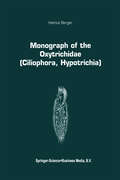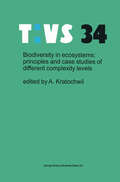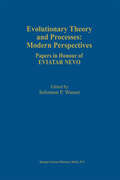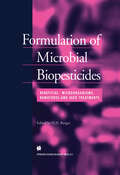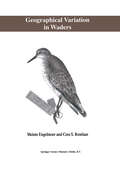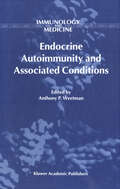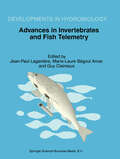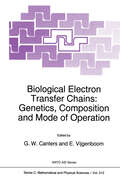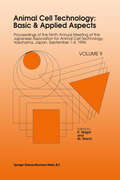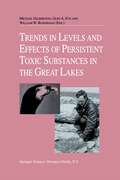- Table View
- List View
Anesthesia for the New Millennium: Modern Anesthetic Clinical Pharmacology (Developments in Critical Care Medicine and Anaesthesiology #34)
by Talmage D. Egan Theodore H.StanleyAnesthesia for the New Millenium: Modern Anesthetic Clinical Pharmacology contains the refresher course lectures of the 1999 meeting and is a review of the current state of the art in anesthesia clinical pharmacology. The authors of the individual chapters are among the world's most widely recognized experts in the pharmacology of perioperative medicine. The book features sections on new pharmacology concepts, new drug delivery techniques, recently released drugs and novel thinking about older drugs. It also addresses several areas that have recently emerged as very hot clinical and research topics, including depth of anesthesia monitoring technology and anesthesia drug interactions. The textbook is the seventeenth in a continuing series documenting the proceedings of the postgraduate course.
Biodiversity in ecosystems: principles and case studies of different complexity levels (Tasks for Vegetation Science #34)
by A. KratochwilThis volume does not aim at merely adding to the vast and increasing number of individual publications on `biodiversity'. Rather it is our objective to investigate biodiversity on the previously little studied coenosis and landscape levels. Phytosociological and animal-ecological fields are considered, as well as theoretical approaches to biodiversity and aspects of its application in nature and landscape protection and preservation. Since biodiversity has so far been predominantly studied in the Anglo-American area, it seemed to be of value to discuss this complex topic from a central and southern European viewpoint, based on data gathered in these regions, and thus to promote a global discussion.
Thermodynamic Optimization of Complex Energy Systems (NATO Science Partnership Subseries: 3 #69)
by Adrian Bejan Eden MamutA comprehensive assessment of the methodologies of thermodynamic optimization, exergy analysis and thermoeconomics, and their application to the design of efficient and environmentally sound energy systems. The chapters are organized in a sequence that begins with pure thermodynamics and progresses towards the blending of thermodynamics with other disciplines, such as heat transfer and cost accounting. Three methods of analysis stand out: entropy generation minimization, exergy (or availability) analysis, and thermoeconomics. The book reviews current directions in a field that is both extremely important and intellectually alive. Additionally, new directions for research on thermodynamics and optimization are revealed.
Rotifera VIII: Proceedings of the VIIIth International Rotifer Symposium, held in Collegeville, Minn., U.S.A., 22–27 June 1997 (Developments in Hydrobiology #134)
by E. Wurdak R. Wallace Hendrik SegersRotifera VIII: A Comparative Approach is a record of the proceedings of the VIIIth International Rotifer Symposium which was held in Collegeville, Minnesota, USA, on June 22-27, 1997. It contains review papers and reports of recent research findings along with the presentation of new methods in rotifer biology. The publications contained in this volume reflect the wide diversity of approaches, methods of analysis and conclusions that characterize research on the Rotifera. Some of the topics addressed are: rotifer distribution, responses to biotic and abiotic factors, genetic profile of individuals and populations, rotifer feeding and mating behavior, morphology, phylogeny and taxonomy. These studies will be of great interest to invertebrate zoologists and limnologists, particularly those interested in freshwater habitats.
Cell Culture Engineering VI (Current Applications of Cell Culture Engineering #3)
by Alison J. Mastrangelo Frank W. R.Chaplen RobArathoon Jeffrey J. Chalmers Michael J. BetenbaughThe latest edition in this continuing series includes the newest advances in the rapidly evolving field of animal cell culture, genetic manipulations for heterologous gene expression, cell line enhancements, improved bioreactor designs and separations, gene therapy manufacturing, tissue engineering, anti-apoptosis strategies and cell cycle research. The contents include new research articles as well as critical reviews on emerging topics such as viral and viral-like agent contamination of animal cell culture components. These papers were carefully selected from contributions by leading academic and industrial experts in the biotechnology community at the recent Cell Culture Engineering VI Meeting in San Diego, USA, 1998. However, the book is not merely a proceedings. Audience: Biochemical engineers, cell biologists, biochemists, molecular biologists, immunologists and other disciplines related to cell culture engineering, working in the academic environment and the biotechnology or pharmaceutical industry.
Evolution and Impact of Transposable Elements (Contemporary Issues in Genetics and Evolution #6)
by Pierre CapyDuring the last 50 years, the perception oftransposable elements (TEs) has changed considerably from selfish DNA to sequences that may contribute significantly to genome function and evolution. The recent increased interest in TEs is based on the realization that they are a major genetic component (at least 10--20%) of all organisms and a major contributor to the mutation process. It is currently estimated that 70--80% of spontaneous mutations are the result of TE-mediated insertions, deletions, or chromosomal rearrangements. Thus, it seems at least plausible that TEs may playa significant role in the adaptation and evolution of natural populations and species. The ubiquity of TEs suggests that they are an old component of genomes which have been vertically transmitted through generations over evolutionary time. However, detailed analyses carried out over the last 20 years have revealed several unusual features of TE evolution: (i) TEs can be horizontally transferred between species; (ii) TE evolutionary rates can be dramatically increased by specific inactivation processes, such as the RIP (Repeat Induced Point mutation) mechanism in fungi; (iii) TEs can influence the regulation of other TEs by insertion or deletion; (iv) different classes of TEs in even distantly related species can be remarkably similar in both structure and function.
Arthropod Relationships (The Systematics Association Special Volume Series #55)
by Richard A. Fortey Richard H. ThomasThe arthropods contain more species than any other animal group, but the evolutionary pathways which led to their current diversity are still an issue of controversy. Arthropod Relationships provides an overview of our current understanding, responding to the new data arising from sequencing DNA, the discovery of new Cambrian fossils as direct evidence of early arthropod history, and developmental genetics. These new areas of research have stimulated a reconsideration of classical morphology and embryology. Arthropod Relationships is the first synthesis of the current debate to emerge: not since the volume edited by Gupta was published in 1979 has the arthropod phylogeny debate been, considered in this depth and breadth. Leaders in the various branches of arthropod biology have contributed to this volume. Chapters focus progressively from the general issues to the specific problems involving particular groups, and thence to a consideration of embryology and genetics. This wide range of disciplines is drawn on to approach an understanding of arthropod relationships, and to provide the most timely account of arthropod phylogeny. This book should be read by evolutionary biologists, palaeontologists, developmental geneticists and invertebrate zoologists. It will have a special interest for post-graduate students working in these fields.
Insect Populations In theory and in practice: 19th Symposium of the Royal Entomological Society 10–11 September 1997 at the University of Newcastle
by Jack P. Dempster Ian F. G. McLeanInsects are by far the largest group of animals on Earth, with over a million described species, and they occupy a wide range of ecological niches - they may be herbivores, predators, parasites or decomposers. Some are of particular economic importance as pests of agriculture and forestry, as vectors of animal and human disease, or as species of interest to wildlife conservation. Thus an understanding of the processes determining their numbers is of considerable practical value. Entomologists have played a leading role in developing a theoretical basis to Population Ecology, but we still do not have adequate experimental and observational proof for many of the theoretical ideas that have been proposed. As a result, the subject has been beset with arguments for more than 50 years. This volume attempts to reconcile some of these controversies, while also reviewing the current state of our knowledge. The editors have drawn together an international list of contributors whose views reflect a range of opinions on how natural populations are stabilised. They have succeeded in producing a book that both covers the main alternative views in population theory and contains some of the best recent field studies of insect populations. This Royal Entomological Society Symposium volume will be of great interest to all entomologists and ecologists, particularly those who wish to know more about Population Dynamics.
Safety in Cell and Tissue Culture
by G. Stacey Alan Doyle P. HambletonIt is now more than half a century since animal cells first came into regular use in the laboratory. Instances of laboratory acquired infection and con tamination of therapeutic products, derived from the use of animal cell cultures are rare. The use of animal cells, in addition to an established role in the production of vaccines and therapeutic proteins, has many new medical applications including gene therapy, tissue engineering and cell therapy. Furthermore, C;ldvances in molecular and cell biology are enabling rapid development and application of these technologies and the development of new and more sensitive methods, such as nucleic acid amplification, for the characterisation of cells and the detection of adven titious agents. However, it is clear that there is no room for complacency in this field and the recent expansion in the use of animal cells in the manufacture of medical products and the development of new biological assays for diagnostic and pharmaco-toxicological screening, underlines the need for vigilance regarding the correct and safe use of animal cells as substrates. This book is therefore very timely and should prove to be a highly valuable text, finding a wider audience beyond those with respon sibility for laboratory safety. The book guides the reader from fundamental cell biology issues and the establishment of new in vitro methods, through testing and validation of cell lines and on to issues in the use of animal cells in manufacturing processes.
Formulation of Microbial Biopesticides: Beneficial microorganisms, nematodes and seed treatments
by H.D. BurgesSound formulation is a vital aspect of microbial products used to protect plants from pests and diseases and to improve plant performance. Formulation of Microbial Biopesticides is an in-depth treatment of this vitally important subject. Written by experts and carefully edited, this important title brings together a huge wealth of information for the first time within the covers of one book. The book is broadly divided into five sections, covering principles of formulation, organisms with peroral and contact modes of action, organisms with the power of search, and future trends. Each section contains comprehensive chapters written by internationally acknowledged experts in the areas covered; the book also includes three very useful appendices, cataloguing formulation additives, spray application criteria and terminology. This outstanding book is a vitally important reference work for anyone involved in the formulation of microbial biopesticides and should find a place on the shelves of agriculture and plant scientists, microbiologists and entomologists working in academic and commercial agrochemical situations, and in the libraries of all research establishments and companies where this exciting subject is researched, studied or taught.
Molecular Approaches to the Study of the Ocean
by K. E. CookseyMarine biological science is now studied at the molecular level and although research scientists depend on information gained using molecular techniques, there is no book explaining the philosophy of this approach. Molecular Approaches to the Study of the Ocean introduces the reasons why molecular technology is such a powerful tool in the study of the oceans, describing the types of techniques that can be used, why they are useful and gives examples of their application. Molecular biological techniques allow phylogenetic relationships to be explored in a manner that no macroscopic method can; although the book deals with organisms near the base of the marine food web, the ideas can be used in studies of macroorganisms as well as those in freshwater environments.
Liver Growth and Repair
by A. Strain A. M. DiehlNelson Fausto The Greek myth of Prometheus with its picture of a vulture feasting on its chained victimhas traditionallyprovided a visualimageofliverregeneration. Itis apowerful and frightening representationbut ifone were to substitute the vulture by a surgeon and Prometheus by a patient laying on a properly prepared operating table, the outcomeoftheprocedurewould not differ significantlyfrom that describedbyGreek poets. Yet few of us who work in the field have stopped long enough to ask where this myth originated. Did the poet observe a case of liver regeneration in a human being? Was it brilliant intuition or perhaps, literally, just a 'gut feeling' of a poet looking for good rhymes that led to the prediction that livers grow when part of the tissueisremoved? Thisbookdoesnotattemptto solve these historical issues. Itdoes, instead, cover in detail some of the major modem themes of research on liver regen eration, injury and repair. As indicated in Dr. N. Bucher's chapter, the modem phase ofexperimental studies on liver regeneration started in 1931 with the publication by Higgins and Anderson of a method to perform a two-thirds resection of the liver of a rat. The technique described has 3 remarkable features: 1) it is highly reproducible, resulting in the removal of 68% of the liver, 2) it has minimal if any mortality, and 3) it consists only of blood vessel ligation and does not involve cutting through or wounding hepatic tissue.
Cladocera: Proceedings of the Fourth International Symposium on Cladocera, held in Postojna, Slovenia, 8–15 August 1996 (Developments in Hydrobiology #126)
by A. Brancelj L. De Meester P. SpaakCladocerans are increasingly used in many fields of science and this volume covers a wide range of such topics. Cladocerans have a strong influence on freshwater ecosystems and in some aspects they can be used in biomanipulation projects. Their fast and easy asexual reproduction offers a wide range of possibilities for studies in many fields of research: genetics, ecology, ecotoxicology, etc. In some ways they are the Drosophila of the present day. Their global distribution makes them of special interest from a phylogenetic and biogeographic as well as an ecological point of view. Apart from the proceedings of previous symposia, there are no other books which cover the whole range of aspects. These proceedings update the last symposia as well as including completely new information on certain fields of research. Target groups are research scientists within ecology, systematic biology, evolutionary biology and population biology. The book could also be a useful source of information for special courses for students of the above mentioned topics.
Geographical Variation in Waders
by M. Engelmoer C.S. RoselaarMorphometrical differentiation 63 Prediction of breeding origin . . . . . . . . . . . . . . . . . . . . . . . . . . . . . . . . . . . . . . . . . . . . . . . . . 68 Body mass 69 Primary moult 69 Discussion . . . . . . . . . . . . . . . . . . . . . . . . . . . . . . . . . . . . . . . . . . . . . . . . . . . . . . . . . . . . . . . 69 The taxonomy of the Eurasian Golden Plover 69 The existence of a partial breast-feather moult during breeding 69 Morphometrical differentiation between both sexes . . . . . . . . . . . . . . . . . . . . . . . . 70 The occurrence of primary moult on the breeding grounds 70 Summary 70 6 Grey Plover - Pluvialis squatarola 71 Introduction . . . . . . . . . . . . . . . . . . . . . . . . . . . . . . . . . . . . . . . . . . . . . . . . . . . . . . . . . . . . . . 73 Morphometrical differentiation 77 Prediction of breeding origin . . . . . . . . . . . . . . . . . . . . . . . . . . . . . . . . . . . . . . . . . . . . . . . . . 80 Accuracy 81 Exclusivity 81 Contact zones . . . . . . . . . . . . . . . . . . . . . . . . . . . . . . . . . . . . . . . . . . . . . . . . . . . . . . . . . . . . 82 Body mass 85 Primary moult 85 Discussion . . . . . . . . . . . . . . . . . . . . . . . . . . . . . . . . . . . . . . . . . . . . . . . . . . . . . . . . . . . . . . . 86 The taxonomy of the Grey Plover . . . . . . . . . . . . . . . . . . . . . . . . . . . . . . . . . . . . . . 86 Small size at northern latitudes . . . . . . . . . . . . . . . . . . . . . . . . . . . . . . . . . . . . . . . . 87 Morphometrical variation in the Palearctic 87 Summary 87 7 Red Knot - Calidris canutus . . . . . . . . . . . . . . . . . . . . . . . . . . . . . . . . . . . . . . . . . . . . . 89 Introduction . . . . . . . . . . . . . . . . . . . . . . . . . . . . . . . . . . . . . . . . . . . . . . . . . . . . . . . . . . . . . . 91 Morphometrical differentiation 93 Prediction of breeding origin . . . . . . . . . . . . . . . . . . . . . . . . . . . . . . . . . . . . . . . . . . . . . . . . . 99 Accuracy 99 Exclusivity 101 Contact zones . . . . . . . . . . . . . . . . . . . . . . . . . . . . . . . . . . . . . . . . . . . . . . . . . . . . . . . . . . . 102 Body mass 102 Primary moult 103 Discussion . . . . . . . . . . . . . . . . . . . . . . . . . . . . . . . . . . . . . . . . . . . . . . . . . . . . . . . . . . . . . . 103 of the Knot . . . . . . . . . . . . . . . . . . . . . . . . . . . . . . . . . . . . . . . . . . . 103 The taxonomy Is the knot breeding in Yakutia? 106 Different degrees of geographical variation in the d'd' and !f!f 106 Summary . . . . . . . . . . . . . . . . . . . . . . . . . . . . . . . . . . . . . . . . . . . . . . . . . . . . . . . . . . . . . . . 107 8 Sanderling - Calidris alba 109 Introduction . . . . . . . . . . . . . . . . . . . . . . . . . . . . . . . . . . . . . . . . . . . . . . . . . . . . . . . . . . . . . 111 Morphometrical differentiation 111 Prediction of breeding origin . . . . . . . . . . . . . . . . . . . . . . . . . . . . . . . . . . . . . . . . . . . . . . . . 116 Accuracy 116 Exclusivity 118 Contact zones . . . . . . . . . . . . . . . . . . . . . . . . . . . . . . . . . . . . . . . . . . . . . . . . . . . . . . . . . . . 118 Body mass 118 Primary moult 118 Discussion . . . . . . . . . . . . . . . . . . . . . . . . . . . . . . . . . . . . . . . . . . . . . . . . . . . . . . . . . . . . . . 118 The taxonomy of the Sanderling . . . . . . . . . . . . . . . . . . . . . . . . . . . . . . . . 118 Sexing Sanderlings 119 Summary . . . . . . . . . . . . . . . . . . . . . . . . . . . . . . . . . . . . . . . . . . . . . . . . . . . . . . . . . . . . . . . 119 VI 9 Curlew Sandpiper - Calidris ferruginea 121 Introduction . . . . . . . . . . . . . . . . . . . . . . . . . . . . . . . . . . . . . . . . . . . . . . . . . . . . . . . . . . . . . 123 Morphometrical differentiation 123 Prediction of a bird's sex . . . . . . . . . . . . . . . . . . . . . . . . . . . . . . . . . . . . . . . . 127 Accuracy 127 Exclusivity 127 Body mass 127 Primary moult 127 Discussion . . . . . . . . . . . . . . . . . . . . . . . . . . .
Endocrine Autoimmunity and Associated Conditions (Immunology and Medicine #27)
by A. P. WeetmanAutoimmunity is the most common cause of endocrine disorders. This volume provides an up-to-date summary of recent advances in this important field. In addition, it describes developments in our understanding of conditions such as vitiligo and pernicious anaemia which are frequently associated with autoimmune endocrinopathies. There is a detailed review of animal models of endocrine disease which have contributed greatly to current knowledge. Furthermore, the aetiology, pathogenesis and treatment of the clinical disorders are discussed in depth. The book will be of interest to anyone working in the areas of endocrinology and immunology.
Advances in Invertebrates and Fish Telemetry: Proceedings of the Second Conference on Fish Telemetry in Europe, held in La Rochelle, France, 5–9 April 1997 (Developments in Hydrobiology #130)
by Jean Paul Lagardere Marie-Laure Begout Anras Guy ClaireauxThis volume provides a selection of the most significant papers presented at the Second Conference on Fish Telemetry in Europe in La Rochelle, France, in April 1997. The conference was attended by 100 scientists from 18 countries. The contributions are grouped under the following headings: Methodology and New Developments, Tagging Procedures, Behavioural and Physiological Ecology, Fish Migration, Stock Management and Conservation. Particular emphasis was put on tag miniaturisation, multiple functions and sampling strategies. Papers concerned the effects of tags on fish for consolidating behavioural or original physiological investigations noticeably more open to the marine environment. Methods were essentially applied to study the relationships between fish and their natural environment. Besides providing up-to-date information on the state of fish telemetry, the book illustrates the increase in spatial and temporal scales and the number of tracked fish which gives a statistical basis for field study in behavioural ecology.
Biological Electron Transfer Chains: Genetics, Composition and Mode of Operation (Nato Science Series C: #512)
by G. W. Canters E. VijgenboomFrom May 3-7,1997, the NATO Advanced Research Workshop on 'Biological Electron Transfer Chains' was organized in Tomar, Portugal. In the application for support the choice of the topic was justified as follows: "[Until recently efforts] have concentrated on the study of the structure and function of individual redox enzymes and proteins. Enough information is now available to make a start with the study of biological electron transfer (E1) at the next higher level of organization, that of the complete ET chain." The interest in the workshop was high: the majority of participants had registered before the workshop was formally announced, which illustrates the popularity of the topic within the biochemical and biophysical communities. The present volume contains a number of reports based on the lectures presented by the key speakers during the meeting. The workshop dealt with the following three themes: a) Electron transfer, which is the subject of Chapter 1. The analysis of ET at the molecular level is still fundamental for an understanding of how ET chains operate in vivo. After 40 years of research the contours of the subject are becoming clear now. b) Bacterial redox chains. This is the subject of Chapter 2. Its contents show how complicated these chains can be, often involving a number of gene clusters. Our understanding of the regulatory aspects and control mechanisms of these chains is only in its beginning.
Animal Cell Technology: Proceedings of the Ninth Annual Meeting of the Japanese Association for Animal Cell Technology, Yokohama, Japan, September 1–4, 1996 (Animal Cell Technology: Basic & Applied Aspects #9)
by K. Nagai M. WachiAnimal cell technology is a growing discipline of cell biology which aims not only to understand structures, functions and behaviors of differentiated animal cells but also to uncover their abilities for industrial and medical purposes. The goal of animal cell technology includes clonal expansion of differentiated cells with useful abilities, optimization of their culture conditions on the industrial scale, modulation of their ability in order efficiently to produce medically and pharmaceutically important proteins, and application of animal cells to gene therapy and formation of artificial organs. This Volume gives the readers a complete review of the present state of the art in Japan, a country where this field is well advanced, as well as in Asia, Europe and the United States. The Proceedings will be useful for cell biologists, biochemists, molecular biologists, biochemical engineers and those in other disciplines related to animal cell culture, working in academic environments as well as in the biotechnology and pharmaceutical industries.
Lake Prespa, Northwestern Greece: A Unique Balkan Wetland (Developments in Hydrobiology #122)
by Alain J. Crivelli George CatsadorakisLakes in the Balkans are numerous, but few of them have been studied, and even fewer on a long-term basis. This book is the first on a lake of the Balkans since the monograph on Lake Ohrid (1956). It is a synthesis of our present knowledge on the ecology and functioning of the lake and its resources, with an emphasis on its endemism and on the management needed to preserve its unique fauna and flora. It also contains original long-term studies on pelicans and fish. The target readership is well-educated lay people, conservationists (especially birdwatchers) and wetland scientists.
Mutation and Evolution (Contemporary Issues in Genetics and Evolution #7)
by Ronny C. Woodruff James N. ThompsonAlthough debated since the time of Darwin, the evolutionary role of mutation is still controversial. In over 40 chapters from leading authorities in mutation and evolutionary biology, this book takes a new look at both the theoretical and experimental measurement and significance of new mutation. Deleterious, nearly neutral, beneficial, and polygenic mutations are considered in their effects on fitness, life history traits, and the composition of the gene pool. Mutation is a phenomenon that draws attention from many different disciplines. Thus, the extensive reviews of the literature will be valuable both to established researchers and to those just beginning to study this field. Through up-to-date reviews, the authors provide an insightful overview of each topic and then share their newest ideas and explore controversial aspects of mutation and the evolutionary process. From topics like gonadal mosaicism and mutation clusters to adaptive mutagenesis, mutation in cell organelles, and the level and distribution of DNA molecular changes, the foundation is set for continuing the debate about the role of mutation, fitness, and adaptability. It is a debate that will have profound consequences for our understanding of evolution.
Trends in Levels and Effects of Persistent Toxic Substances in the Great Lakes: Articles from the Workshop on Environmental Results, hosted in Windsor, Ontario, by the Great Lakes Science Advisory Board of the International Joint Commission, September 12 and 13, 1996
by William W. Bowerman Glen A. Fox MichaelGilbertson`Are the Great Lakes getting better or worse?' This is the question that the public, scientists and managers are asking the International Joint Commission after a quarter-century of cooperative action by the United States and Canadian governments to clean up the Great Lakes. This volume contains papers from the workshop on Environmental Results, hosted in Windsor, Ontario, by the Great Lakes Science Advisory Board of the International Joint Commission, on September 12 and 13, 1996. The Great Lakes have been through almost a century of severe pollution from the manufacture, use and disposal of chemicals. In the 1960s wildlife biologists started to investigate the outbreaks of reproductive failure in fish-eating birds and ranch mink and to link these to exposure to organochlorine compounds. Human health researchers in the 1980s and 1990s linked growth retardation, behavioral anomalies and deficits in cognitive development with maternal consumption of Great Lakes fish prior to pregnancy. The Great Lakes became the laboratory where the theory of endocrine disruptors was first formulated. Now a group of Great Lakes scientists, hosted by the International Joint Commission, has compiled the story of the trends in the concentrations and effects of persistent toxic substances on wildlife and humans. The technical papers review the suitability of various organisms as indicators, and present the results of long-term monitoring of the concentrations and of the incidence of effects. The evidence shows that there was an enormous improvement in the late 1970s, but that in the late 1990s there are still concentrations of some persistent toxic substances that have stubbornly remained at levels that continue to cause toxicological effects.
Aspects of Littorinid Biology: Proceedings of the Fifth International Symposium on Littorinid Biology, held in Cork, Ireland, 7–13 September 1996 (Developments in Hydrobiology #133)
by Ruth M. O'Riordan Gavin M. Burnell Mark S. Davies Neil F. RamsayMembers of the family Littorinidae are among the most widely studied gastropod molluscs and the more questions we answer about this group, the more questions are inevitably posed. Littorinid research spans diverse disciplines, from molecular biology, physiology, ecology, systematics and evolutionary biology to elegant anatomical studies. The papers n this volume reflect the current research being carried out on littorinids, and fall into three broad themes: systematics, ecology, and pollution studies. This book is primarily targeted at the research level, while providing useful information for advanced first-degree students conducting research projects.
Insect Pheromones and their Use in Pest Management
by P. Howse J.M. Stevens Owen T JonesThere is now a considerable literature on chemical ecology, which had its beginnings in the study of insect pheromones. This beginning was possible only by combining the disciplines and techniques of biology and chemistry. For a biologist, it is difficult to understand the time frames of analytical and synthetic chemistry. A compound may take days to characterize and be available in minutes from a bottle on the shelf, or it may take years to characterize and synthesize. Chemists have a similar frustration: after an intense programme of work, the insect in question may not emerge for many months. study are, however, The rewards of integrated interdisciplinary considerable, because they allow us to understand many facets of insect behaviour and consequently to control that behaviour for our own ends. In this book, we have set out to explain the results of research from chemical and biological perspectives, and see how the knowledge gained has led to novel techniques that can be used in insect pest management and insect control. An important part of understanding insect chemical ecology involves the understanding not only of new concepts but of the vocabularies used by scientists specializing in different fields. It will be clear that the three sections of this book have been written by three different people: an insect behaviourist, an organic chemist and a biologist in industry.

